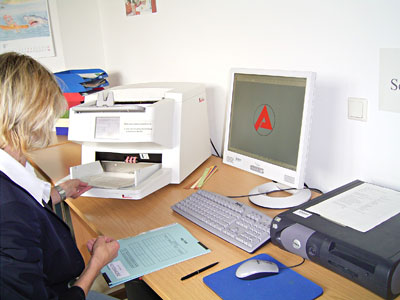Behördenspiegel - September 2005
Federal Employment Agency
Modern IT strategy for more service and efficiency
In a concept test, the Federal Employment Agency is gathering experience for a nationwide introduction of the electronic file based on a document management system. The flexible capture software DpuScan ensures a smooth capture process. In order to make processing more economical, faster and, above all, more service-friendly, the Federal Employment Agency (BA) is committed to the increased use of information technology. Particularly in the areas of unemployment benefits (ALG), promotion of continuing vocational training and child benefits – a task that belongs to the Federal Ministry of Finance and the Federal Ministry of Family Affairs, but is carried out by the Family Welfare Office by way of a loan of organs – the digitisation of benefit files and subsequent transfer to a document management system should ensure more efficiency in processing and thus increased service.
At the end of 2004, the federal authorities therefore started preliminary work on the ELEISA concept test in two of the 180 nationwide employment agencies responsible for the direct execution of specialist tasks and in two of the former 179 family benefits offices. The aim is to replace the documents for the payment of unemployment benefits and child benefits, which were previously only available in physical form, with an electronic file and thus not only to speed up the processing procedures, but also to be able to provide information immediately in the case of telephone and written enquiries. This is a service that is not yet possible in this form – after all, the time-consuming search for the paper file due to the subdivision and spatial separation of the customer centre as the first point of contact for the unemployed as well as the spatial separation of the service centres and the offices responsible for processing benefits stand in the way of immediate access to the required information.
For project worker Thomas Geisler, this is a state of affairs that is no longer up to date for the BA: “We want to achieve continuous electronic case processing, where you can pull up a file on the screen and make a decision at any time.” The experiences and results in Göppingen in Swabia and Schwandorf in Bavaria as well as in Hanover (only unemployment benefits), Ludwigsburg and Regensburg (only child benefits) will therefore be the basis for the decision on a nationwide introduction after the project is completed in 2006.

High demands
The complexity of the project – the nationwide realisation would be one of the largest DMS applications in Germany – not only confronted the internal IT system house responsible for the pilot project with enormous demands. The suppliers participating in the public tendering procedure for scanners and scanning software were also faced with an extremely extensive catalogue of requirements. A total of fifty compulsory criteria had to be fulfilled, and eighty additional desired criteria were listed. The evaluation of the offers was based on a predefined point system.
Janich & Klass Computertechnik GmbH from Wuppertal won the selection with the best price/performance ratio. Their complete solution, consisting of the powerful capture software DpuScan 4.11 developed in-house and the SCAMAX 401cd batch scanners from the Wölfersheim-based manufacturer InoTec Organisationssysteme GmbH, convinced with the high functionality and necessary flexibility offered. “For our scanning process, an out-of-the-box solution cannot be used without programming adaptation,” Thomas Geisler explains the decision. “The decisive factor for us was therefore that the solution supports a multi-stage process from scanning to image processing to quality assurance and that we could write our own modules where no standardised functions are available. For example, we need to access our legacy databases to verify the data. And that can’t be covered by a standard solution.” Neither is a number of specifics in child support. The prerequisite for covering these individual requirements is provided by DpuScan via a standard plug-in interface.
And Janich & Klass scored with another advantage. Although the agencies scan in duplex, they delete about 50 percent of the pages again, as they are irrelevant for the transaction processing. The option offered of billing on a speed basis rather than on a page basis was therefore very convenient for the Nuremberg-based company. The chosen billing method is now independent of the volume, so that even if the volume to be scanned increases, the cost share does not increase.
Successful start
In the meantime, the model agencies have processed about 50,000 files – faster than planned in the schedule – in the area of unemployment benefits about 10,000 files with 30 to 40 pages per file, in the area of child benefit 40,000 files with an average of 120 pages. These are extremely heterogeneous records, which are a challenge for the scanning systems both because of the different formats and because some of the material is difficult to read. However, thanks to the reliable feed and transport system of the SCAMAX scanners with standard ultrasonic sensor for detecting double-sheet feeds, easy handling and reliable processing are guaranteed. Nevertheless, it became apparent at the beginning that sometimes a single hand movement can make the difference between success and failure. “We had quite high error rates in the beginning because we scanned the documents with the punched holes first,” Thomas Geisler remembers. “But since the papers often tore, they got stuck. We then simply rotated the documents, and from then on it worked flawlessly.”
All in all, the start-up was an outstanding success. Although without any previous knowledge, after a short training session the staff were able to operate the systems within a very short time without any significant problems. The powerful features of the scanning programme make it possible. For example, the classification of the numerous different document and form types facilitates the use of barcodes or matrix codes with key data already provided, such as processor, date of creation, future file customer number, etc., the subsequent indexing process – which, however, is preceded by quality assurance. Here, pages that are not needed are deleted, image corrections are made if the quality is poor – without having to rescan due to the high image quality provided by SCAMAX – and, above all, it is checked whether a barcode that has been applied has actually been read. Experience so far has shown that this process is relatively quick. Of course, this is helped by the fact that the software allows the job to be transferred to any other scanning sub-process at any time – be it for rescanning or for immediate or later transfer to the indexing module.
Since at this stage the codes do not yet contain all metadata, indexing is also done manually. “We always have to add to the data, for example the customer number,” says process developer Stefan Schneider. “It is the most important thing, because it ensures that the document is assigned to the correct file.” A future goal here is to further reduce the indexing effort by increasingly issuing personalised documents with data already integrated into the matrix code, such as the customer number, etc. The process developer Stefan Schneider says: “This is the most important thing, because it ensures that the document is assigned to the right file.
Another random quality assurance after indexing ensures that any errors during processing can be detected and corrected immediately.
Incidentally, scanning is done in colour with subsequent conversion into black-and-white images. In this way, the quality of the images can be corrected better, especially in the case of coloured, yellowed or dirty originals, than would be possible with immediate scanning in black and white.
So far, the feedback has been unanimously positive. One reason for this is certainly that the BA has intensively involved the staff in the processes.

